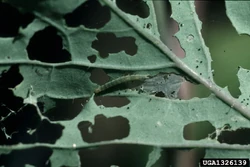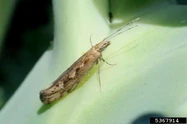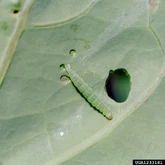| Diamondback moth | |
|---|---|
 |
|
| Diamondback moth caterpillar on a broccoli leaf | |
| Scientific Classification | |
| Kingdom: | Animalia |
| Phylum: | Arthropoda |
| Class: | Insecta |
| Order: | Lepidoptera |
| Family: | Plutellidae |
| Genus: | Plutella |
| Species: | Plutella xylostella |
| Synonyms | |
| Cerostoma xylostella (Linnaeus, 1777) |
|
The diamondback moth (Plutella xylostella), sometimes called cabbage moth, is a European moth believed to originate in the Mediterranean region that has since spread worldwide. The moth has a short life cycle (14 days at 25°C), highly fecund and capable of migrating long distances.[1] It is one of the most important pests of cole crops in the world and will usually only feed on plants that produce glucosinolates.[1] However, not all of these plants are equally useful as hosts to the moth; there has been some discussion[2] of using wintercress as a buffer plant around agricultural fields as diamondback moths are highly attracted to that plant but their eggs fail to survive when oviposited on it.
The diamondback moth is most important as a pest in areas that do not experience very cold winters, as these help to kill off overwintering moths.[1]
Symptoms[]
Signs are first shown as damage on the underside of leaves between leaf tissues. Later; feeding will show as holes in leaves, or holes in the underside leaving a thin membrane on the top-side. Damage only between veins. Seedlings have growing tips eaten and appear stunted.[3]
Treatment[]
Observe the plants regularly, if diamondback moth populations are increasing, then start applying the natural insecticides Bacillus thuringiensis or neem.
Prevention[]
Clean cultivation[]
Diamondback moth larvae and pupae remain in plant debris so sites should be cleared of all plant debris after harvest. Keep growing sites clear of weeds.[3]
Netting[]
Covering individual plants or whole beds with fine mesh netting will inhibit diamondback moths and other pests from laying their eggs on plants and reduce the need for other control methods.
Examples[]
References[]
- ↑ a b c Talekar, N.S. Shelton, A.M. (1993). Biology, ecology and management of the diamondback moth. Annual Review of Entomology. vol 38. p 275–301. doi: 10.1146/annurev.en.38.010193.001423.
- ↑ F. R. Badenes-Perez, B. A. Nault & A.M. Shelton (2006). "Dynamics of diamondback moth oviposition in the presence of a highly preferred non-suitable host". Entomologia Experimentalis et Applicata 120 p 23-31. doi:10.1111/j.1570-7458.2006.00416.x
- ↑ a b B.L. Parker, N.S. Talekar & M. Skinner. (1995). "Field Guide: Insect Pests of Selected Vegetables in Tropical and Subtropical" Asia. p 94-427. Retrieved 2010-07-19
| This page uses Creative Commons Licensed content from Wikipedia (view authors). |
| Brassica troubles |
|
|---|---|
| Broccoli · Brussels sprout · Cabbage · Cauliflower · Kale · Kohl rabi · Radish · Swede · Turnip | |
| Adverse conditions | Blown sprouts · Bolting · Boron deficiency · Button cauliflower · Calcium deficiency · Heartless cabbage · Magnesium deficiency · Manganese deficiency · Molybdenum deficiency · Nitrogen deficiency · Split heart |
| Diseases | Anthracnose · Bacterial soft rot · Black leaf spot · Black rot · Brassica dark leaf spot · Club root · Downey mildew · Grey leaf spot (Brassica) · Turnip mosaic virus · Sclerotinia rot · White leaf spot · White leaf spot (Brassica) · White rust · Wire stem |
| Pests | Aphid · Cabbage aphid · Cabbage Moth · Cabbage root fly · Cabbage Whitefly · Cutworm · Diamondback moth · Flea beetle · Large White · Pigeon · Silver Y moth · Slug · Small White · Swede midge · Thrips |

